Insights & Experiences from OroVibe 2022
Recently Patrick Hathway our Lead Developer attended OroVibe 2022 in Paris, where we were delighted to receive the Momentum Oro Brilliance Award 2022. Here’s his experience.
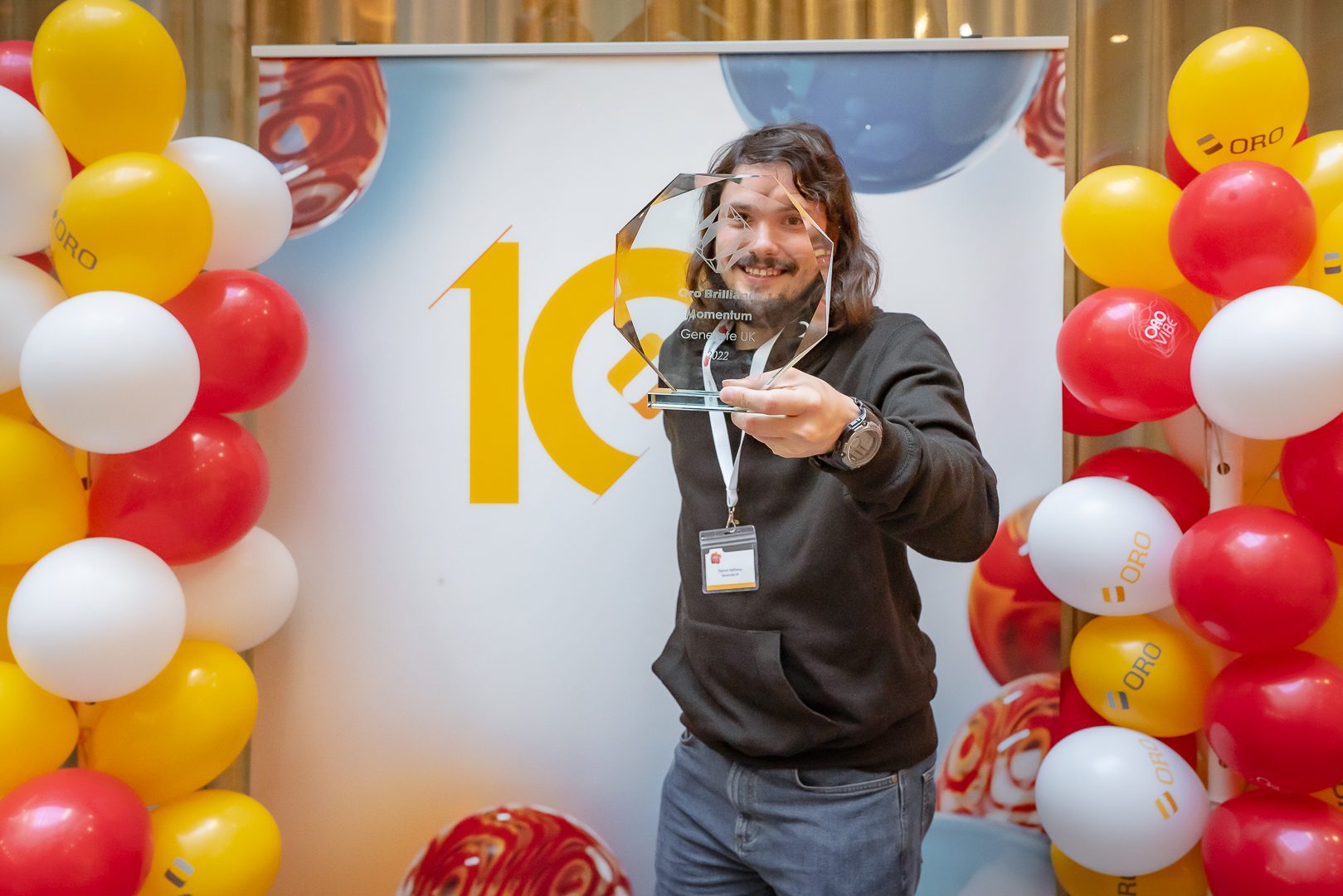
During the last few years, Generate UK has built some large websites using both the Enterprise and Community editions of the excellent OroCommerce platform, which is a very powerful and flexible system that supports both B2B & B2C eCommerce, Marketplace and CRM capabilities.
We are proud to be the first UK-based partner of Oro Inc, and have had some great experiences working with this platform.
It was therefore with some excitement that I found myself at St Pancras International station, on the way to Paris to attend the OroVibe event on behalf of my team!
Arriving at OroVibe
On the morning of the conference, I was served breakfast in bed at my hotel – a very nice start to the day!
After a metro ride which was a little more “exciting” than I had anticipated (the designers of the Paris Metro certainly made an inspired choice when they decided to begin the name of 2 different stations at opposite ends of the same line with the phrase “Mairie d’…”!), I arrived at the conference centre.
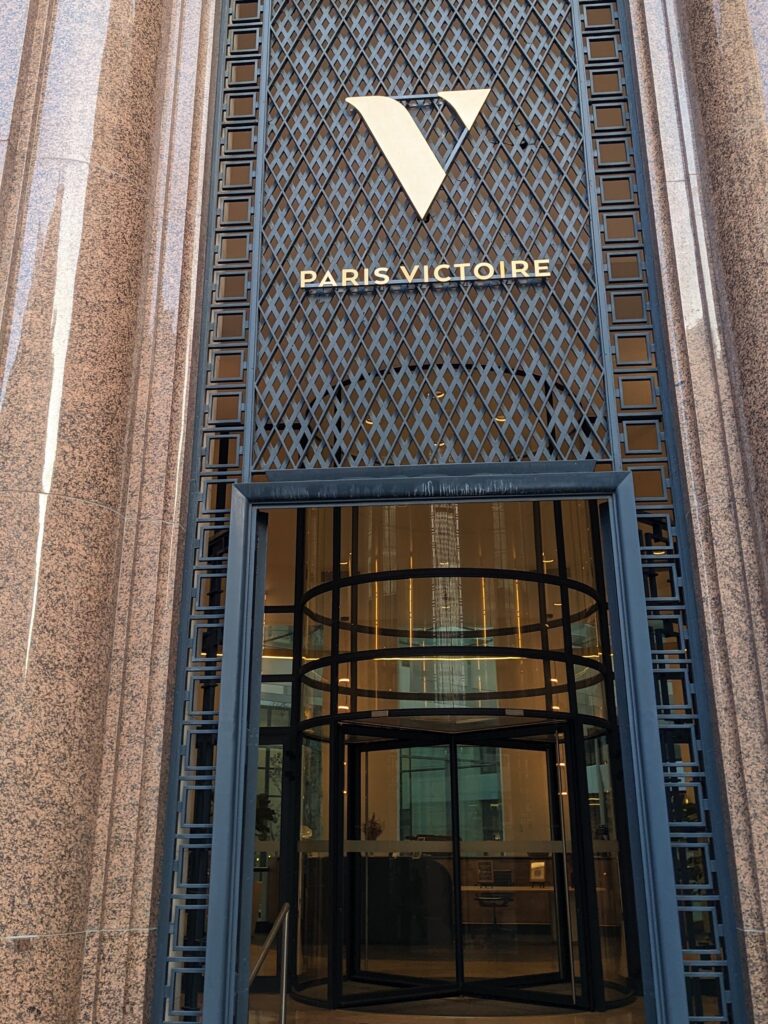
It was clear that this was a particularly important event from Oro’s perspective, as it marked a celebration of the 10th year anniversary since they were founded!
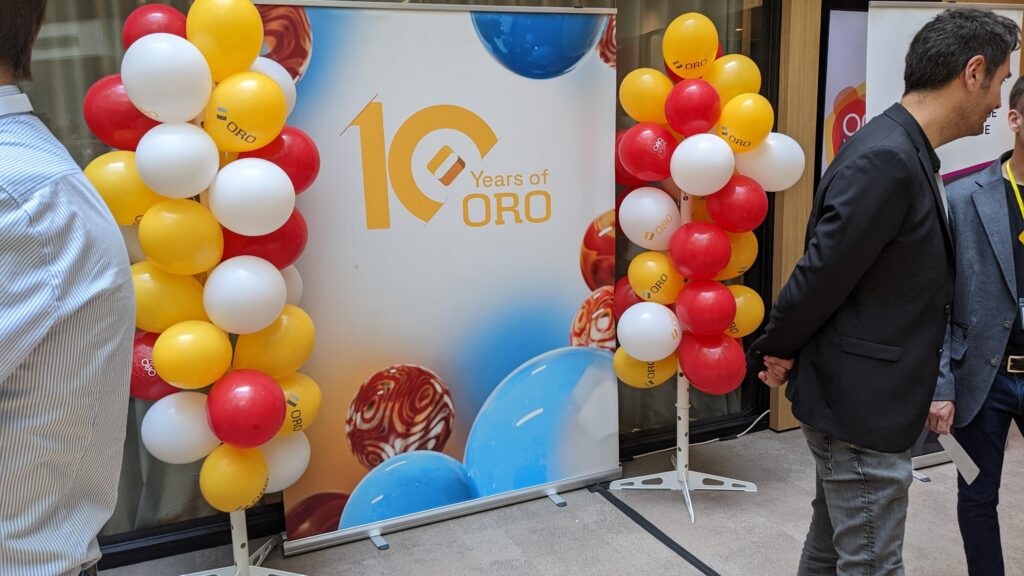
Intro Talk: A decade in B2B eCommerce: Lessons Learnt and Future Vision
After registering and collecting my OroVibe pack from reception, it was time for the first talk at the conference. During this talk, Yoav Cutner (the CEO and a founder of Oro), Laurent Desprez (the Executive VP General Manager Europe at Oro), and Dima Soroka (the CTO and a founder of Oro) told us about their experiences of working on a B2B eCommerce platform during the last 10 years, plus their future vision.
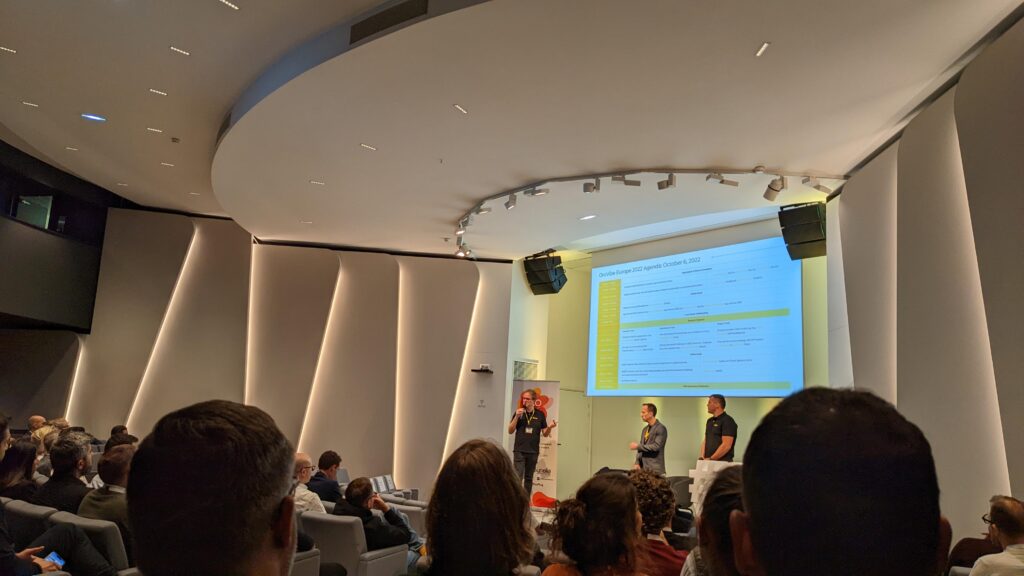
Background to Oro
It is worth noting that the founders of Oro originally also founded Magento – one of the most well-known and widely used eCommerce platforms out there, which Generate UK also has extensive experience working with.
However Magento was historically built primarily to support B2C (i.e. Business-to-Consumer) e-commerce transactions, and official support for B2B (Business-to-Business) capabilities was only released in the Enterprise Edition of Magento fairly recently.
After Magento was acquired by Adobe, the team who are now behind Oro had a unique insight: Many of the requirements of businesses are quite complex and specialised, with business rules that vary quite dramatically from the company.
Therefore building a solid platform that is structured to support B2B requirements very well from the outset – and then expanding this platform to additionally support B2C capabilities – is actually easier in many ways than attempting to retrofit B2B capabilities onto a legacy B2C platform.
As a result, Oro is now one of the leading B2B platforms – and yet also provides built-in support for B2C capabilities (or even B2B2C capabilities, or indeed any other combination) within the same platform – whereas Magento’s B2B offerings are much less mature.
Oro has thus been experiencing dramatic growth recently – with 80% more customers compared to last year, and yet achieving a retention rate of 95% of their existing customers!
The speakers shared some other impressive stats, including the fact that more than 2.5 million orders have been placed this year via their platform, which equates to a total order value of $1.6 billion so far in 2022!
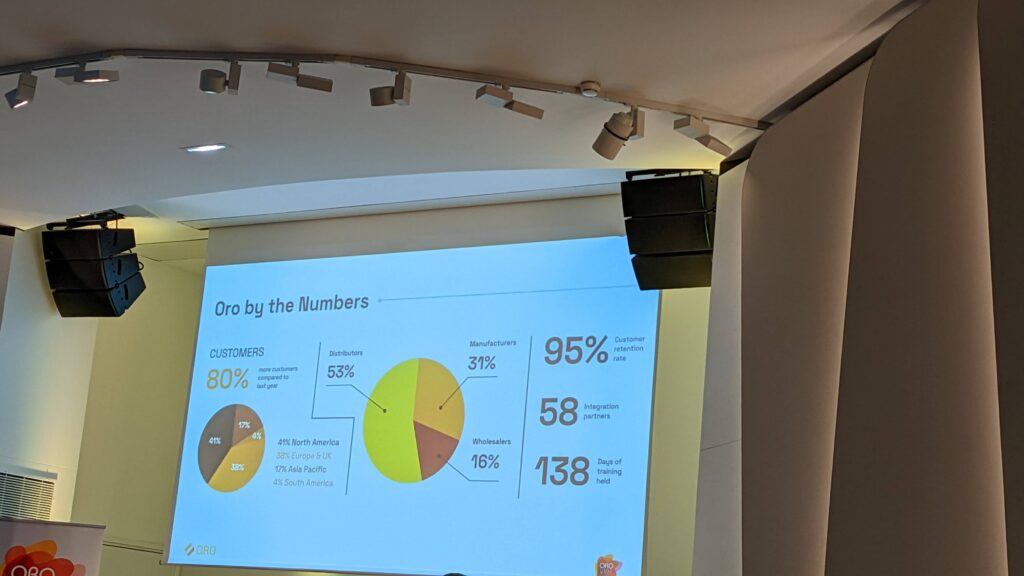
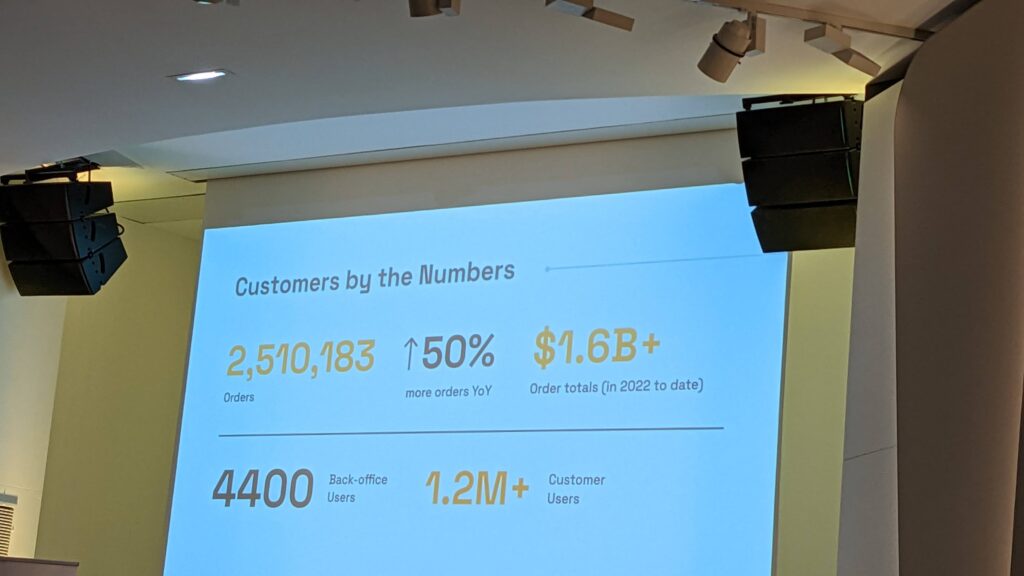
Nevertheless, there have undoubtedly been challenges during this time – most notably COVID-19, the current economic climate, and the current conflict in Ukraine.
Oro actually has quite a large team based in Ukraine – however, they were paying close attention to various signs over the last few years – and so as a result, they had detailed contingency plans.
This meant that at the start of the conflict earlier this year, they were able to rapidly relocate their team to a safer location, and impressively they did not notice any drop in productivity as a result of this major change! They also set up a special fund to help support the people in Ukraine.
Why Oro is a Compelling Option
When Oro was being built, they took the opportunity to build Oro upon a modern and robust technology stack, based upon the Open Source Symfony Framework.
They built the system in a very modular way, with the aim of building a system that could cater to 80% of business needs out of the box, whilst providing the flexibility and capabilities to make it possible to build out custom functionality that can achieve the remaining needs.
The speakers mentioned that there are several key drivers for businesses to move to platforms such as Oro:
- To reduce & update the number of technologies that are relied upon by a business. A lot of companies have out-of-date tech stacks that are costly and time-consuming to support. Being able to achieve multiple aims (such as setting up multiple B2B & B2C stores) within a single platform was particularly compelling.
- To provide a new channel to be able to sell products to both existing and new markets.
- To increase the amount of automation to fulfil complex yet routine business rules – and thus free up salespeople to be able to work on more productive tasks, with more time to be able to find new customers and help grow their business.
Oro is particularly proud that they have been rapidly moving up the Gartner Magic Quandrant during the last 3 years, and is now regarded as a “Visionary”. Oro has been a truly disruptive technology, and has thus been recognised by Gartner; making a big impression within a short space of time!
Many of the other existing companies on there are relatively traditional, and rely on legacy technologies – and so there is therefore potential for further movement up these rankings…
Upcoming Oro Features
Oro typically releases one LTS (Long Term Support) version of their platform per year; the next version is currently due to be released in March 2023.
They are working on a number of exciting new features that continue to expand Oro’s impressive capabilities:
- An admin area UI for the catalogue search feature, making it easier for marketers to manage this more easily, without needing to have deep technical knowledge. Features include being able to define specific landing pages for search terms, set up synonyms for common keywords, adjust the ordering of search results etc.
- The ability to set up and configure product ‘kits’ (bundles).
- The ability to switch on or switch off features more easily depending on the Organization type on the platform, as well as the ability to support multiple Organizations on a single storefront.
- Updates to the Oro tech stack, supporting the latest versions of PHP, Symfony, NodeJS, etc; as well as supporting a bundle-less application structure.
Oro were also excited about some features that have already been released within the current version of Oro 5.0.x this year, which Generate UK have been utilising within projects we are working on.
This includes built-in support for Google Analytics 4 (N.B. previous versions of Google Analytics are due to be discontinued in July next year), support for pre-defined content ‘templates’ which can be added by integrators such as ourselves and then adapted by marketers via drag & drop UI, built-in support for ‘fixed’ product shipping costs, support for fuzzy search, performance improvements, and 250+ other improvements and fixes.
Oro is also working on some very exciting improvements to its Cloud infrastructure, which Generate UK use to host our Oro Enterprise projects upon. As a developer myself, I was particularly excited to hear about these plans:
- The ability to deploy code changes with zero downtime, as well as reductions in the overall amount of time it takes to deploy changes.
- A new Docker-based CI/CD (Continuous Integration/Deployment) system, which should make code deployments quicker, more automated, more robust, more consistent, and potentially provide the ability to integrate with our automated test suites, helping to increase confidence in the quality and reliability of deployed code. I am very much looking forward to trying this new feature out!
- A new virtual development environment, making it possible for developers to start working with Oro more easily.
A Steve Jobs Moment…
It was then time for a big announcement:
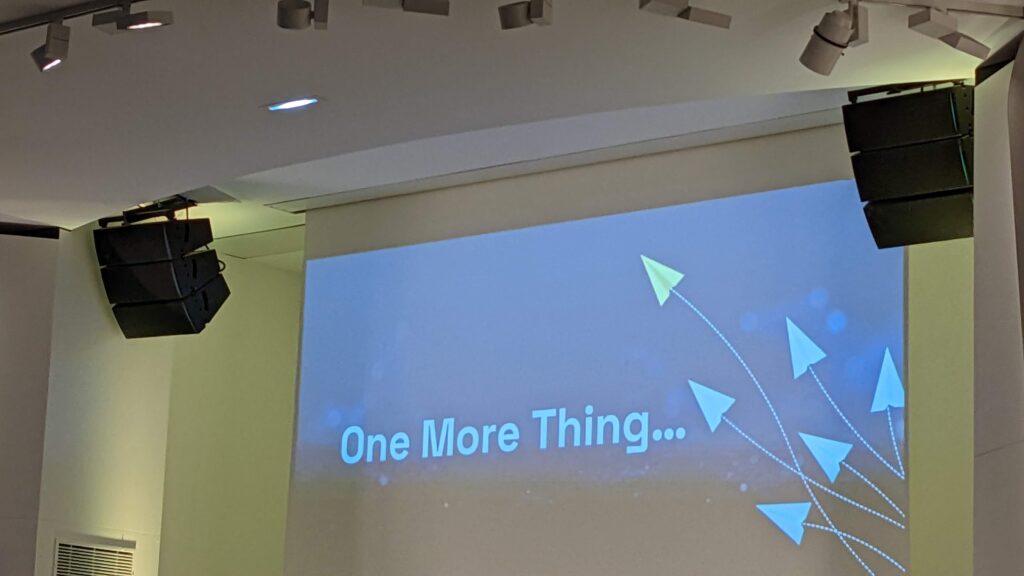
Oro then informed us that a new round of Series B funding for Oro has just been agreed with investors!
This provides many future opportunities for Oro to grow, expand and continue to develop its fantastic products. The ink is still drying on this agreement, so undoubtedly we will learn more about it in due course… Overall though, it is clearly a very exciting time for Oro!
Talk: The Digital Commerce & Marketplace Ecosystem
There was then a talk about the overall digital commerce and marketplace ecosystem. Notably, COVID-19 accelerated the move towards e-commerce within both the B2C and B2B markets. Strikingly though, although there are fewer online B2B stores, in terms of overall revenue, digital B2B commerce is currently 5 times bigger than B2C commerce.
B2B commerce has a duality which is not present with B2C commerce, however – i.e. both the seller and the buyer often have specialised requirements, business rules and processes that need to be followed; hence the need for a platform that can cater to these requirements.
There are currently fewer digital B2B marketplaces, but revenue is growing in this area rapidly.
In general, products that are not heavily tailored or customised tend to work best for current e-commerce platforms; however, one alternative approach is to sell ‘services’ online, where the service that is being sold is the customisation or tailoring of a product to meet the specific needs of a company. This is an area which is ripe for future expansion.
Networking with Event Participants
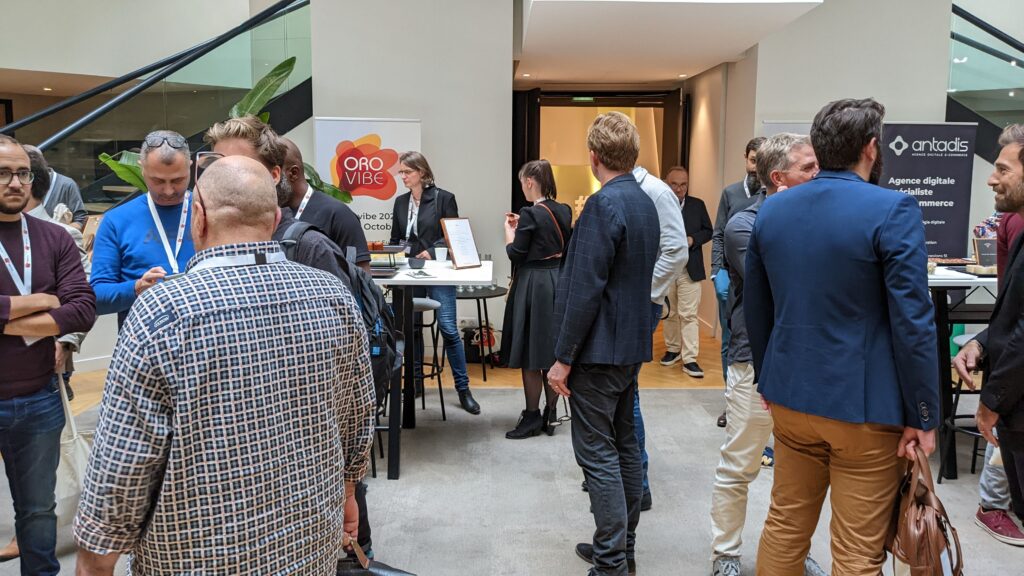
During the breaks, it was great to speak to various members of the Oro team (including Chris Raven – the official UK Oro representative, and Yoav Kutner – the CEO of Oro Inc), as well as to Oro customers and other Oro partner organisations.
One thing that struck me during these discussions was that during the early days of Magento, there was a huge emphasis on building a community plus an ecosystem of partners and 3rd party developers who could build extensions to build upon the core functionality, as well as initiatives such as Magento Go to make it easy to get started with the platform.
It sounds as though Oro is pursuing a similar strategy, and is actively looking at ways of building its ecosystem – which I believe is a very good sign for the health and growth of the platform.
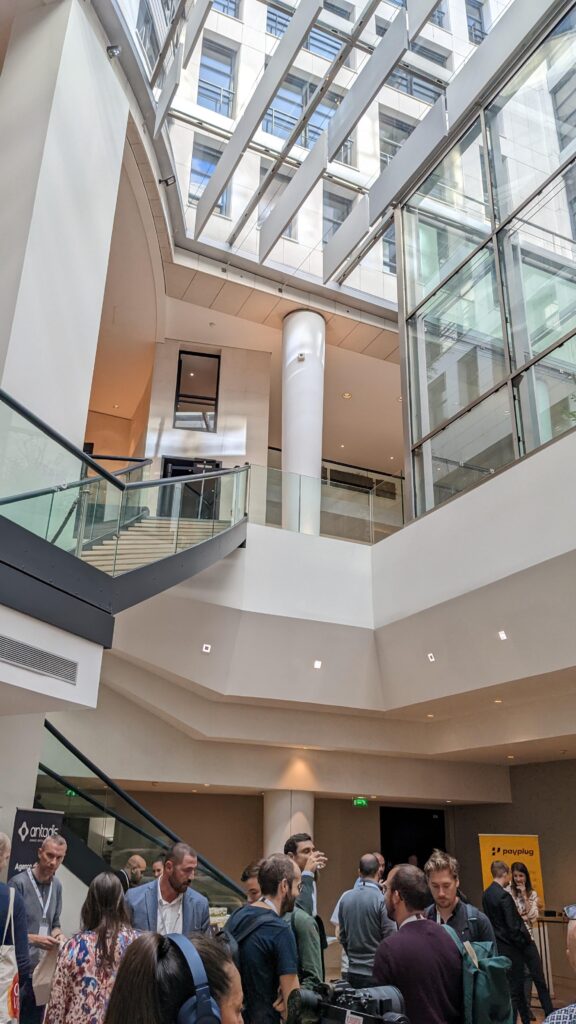
Talk: Driving Innovation
After lunch was a light-hearted talk about ways to foster innovation.
The overall theme of the talk was that although it may sound challenging to be truly innovative; by doing lots of small things, it is possible to ultimately achieve big things – for example by improving existing processes, systems and products, rather than necessarily inventing something completely new. In the talk, 4 main levels of innovation were outlined, with some examples:
1. Re-invention of a core process: For example, the people behind Slack originally produced an internal chat tool to meet their own needs, but ultimately found it so effective that they released it publicly, revolutionising digital communication. Similarly, on a recent Oro project, there was lots of useful product manufacturer information but it was in silos, e.g. within lengthy unstructured documents. In this case, AI was used to extract this info from the documents in a structured format, so that it could be presented in more useful ways to customers.
2. Continuous improvement of an existing product: For example, a US fitness studio advertised “Pizza Mondays”, thus encouraging a whole new set of potential customers to attend. In the recent example Oro project, an “e-Lab” system was implemented, providing a tailored guide to introduce new customers to a product range.
3. Leveraging existing assets for new growth: For example, Nintendo used their existing assets to come up with new concepts such as the Wii and Switch, instead of competing directly with Sony or Microsoft to build a high-spec gaming platform – and thus appealed to a whole new audience of more casual gamers. On the Oro site example, a knowledge base was set up, to provide access to a wide range of materials showcasing expertise.
4. The next big thing: This level involves the invention of something truly new. For example, Spotify fundamentally changed the way that many of us listen to music.
The overall conclusion was that it is possible to do little things to gradually proceed through these levels of innovation; iterating and improving over time. By exchanging ideas with customers, partners and peers, and collaborating with them, it is possible to achieve some amazing things! This was all quite inspiring and made me reflect on ways we can foster innovation in our own projects…
Talk: Price Syncing with ERP Systems
As a developer, I found this talk one of the most interesting ones – it outlined various approaches and mechanisms for syncing prices between external ERP system(s) and an Oro website. It covered a variety of areas:
- Discovery: Gaining an initial understanding of the existing product pricing, how and where it is stored, and what price syncing requirements there are.
- Pricing Models: Understanding the pricing structures, e.g. a base price and/or customer-specific prices, price tiers, promotional pricing, taxes, shipping & admin costs, B2B vs B2C costs, any edge cases to consider, etc.
- Integration: Where and how the prices are calculated (e.g. within the ERP system, within Oro, or a combination), and what mechanisms are available to sync pricing between both systems (e.g. batch import or real-time API), taking into account performance and technical considerations.
- Visualisation: I.e. how and where the prices will be presented on the front end. For example on product pages, search & catalogue pages, search autocomplete, sorting and filtering etc.
- Performance: Since there is inevitably a trade-off between the complexity of the pricing, how up-to-date the pricing needs to be, and where it needs to be displayed on the website; vs the impact that these requirements could have upon the performance and loading speed of the website and ERP system.
During the talk it was emphasised how important it is to get to know the client at an early stage of the project, gaining insights into the business, as well as the available products and how pricing works; before going ahead with full integration.
Some considerations that may seem relatively minor could have a big impact on the overall price-syncing strategy.
The number of prices could also have a big impact, and there may also be opportunities to streamline the pricing models to increase business efficiency and improve system performance.
It was encouraging to see that the outlined approaches were very much in line with the approaches that Generate UK takes when working on ERP & Oro price syncing for our client projects.
Some very creative strategies were also suggested and brainstormed to reconcile the need to show the most accurate and up-to-date pricing possible; whilst also ensuring that any negative performance impacts on the system are kept to a minimum.
The best approach undoubtedly varies depending on the needs of the project – but there were certainly some valuable suggestions that we can potentially utilise on our future projects.
The Oro Brilliance Awards Ceremony
After the main talks had concluded, it was time for the awards ceremony! There was suddenly a big announcement:
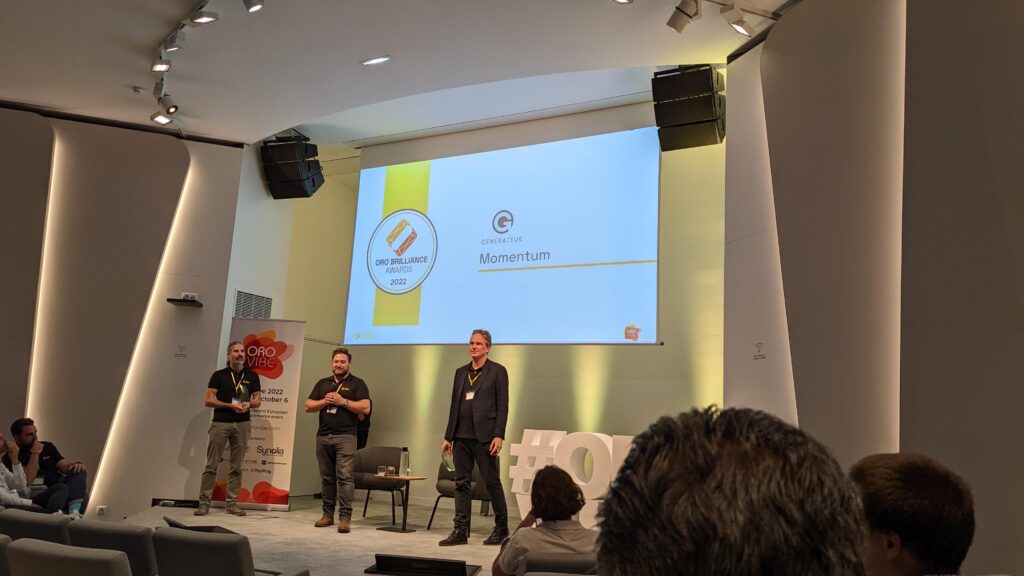
I found myself walking onto the stage, in order to receive Generate UK’s Momentum award, and to give a brief impromptu acceptance speech!
I was very honoured to receive the award on behalf of my company – and believe it is a true testament to all of our hard work over the last few years.
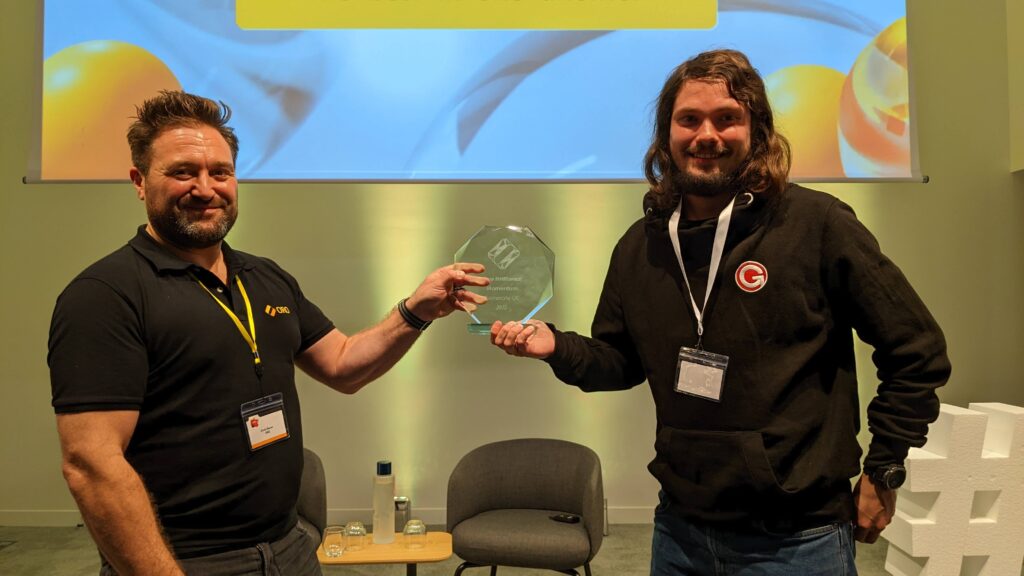
After the Conference
Shortly after that, it was the end of the formal conference.
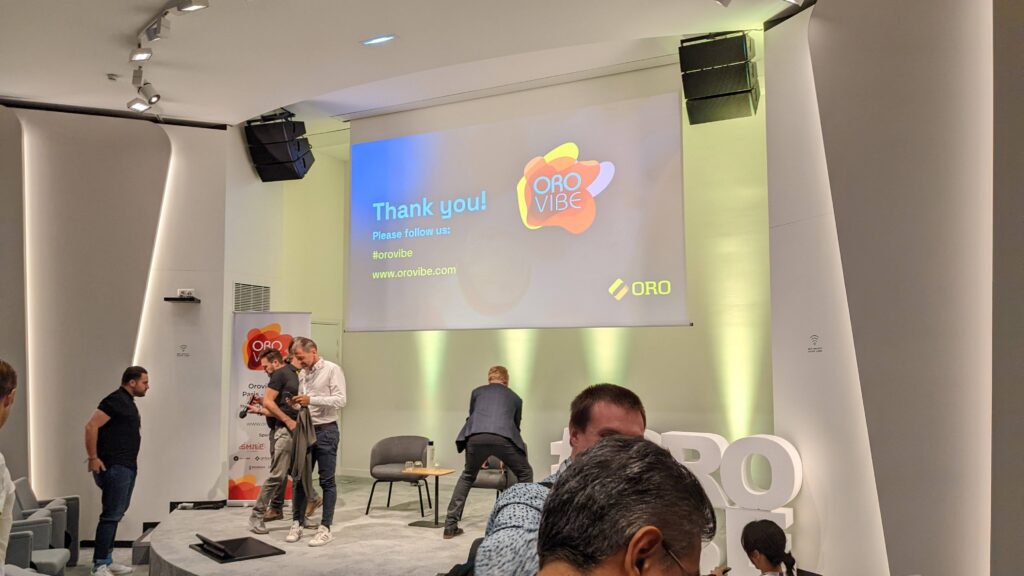
We then moved back into the central room, where we were confronted with a gigantic pyramid of delicious snacks:
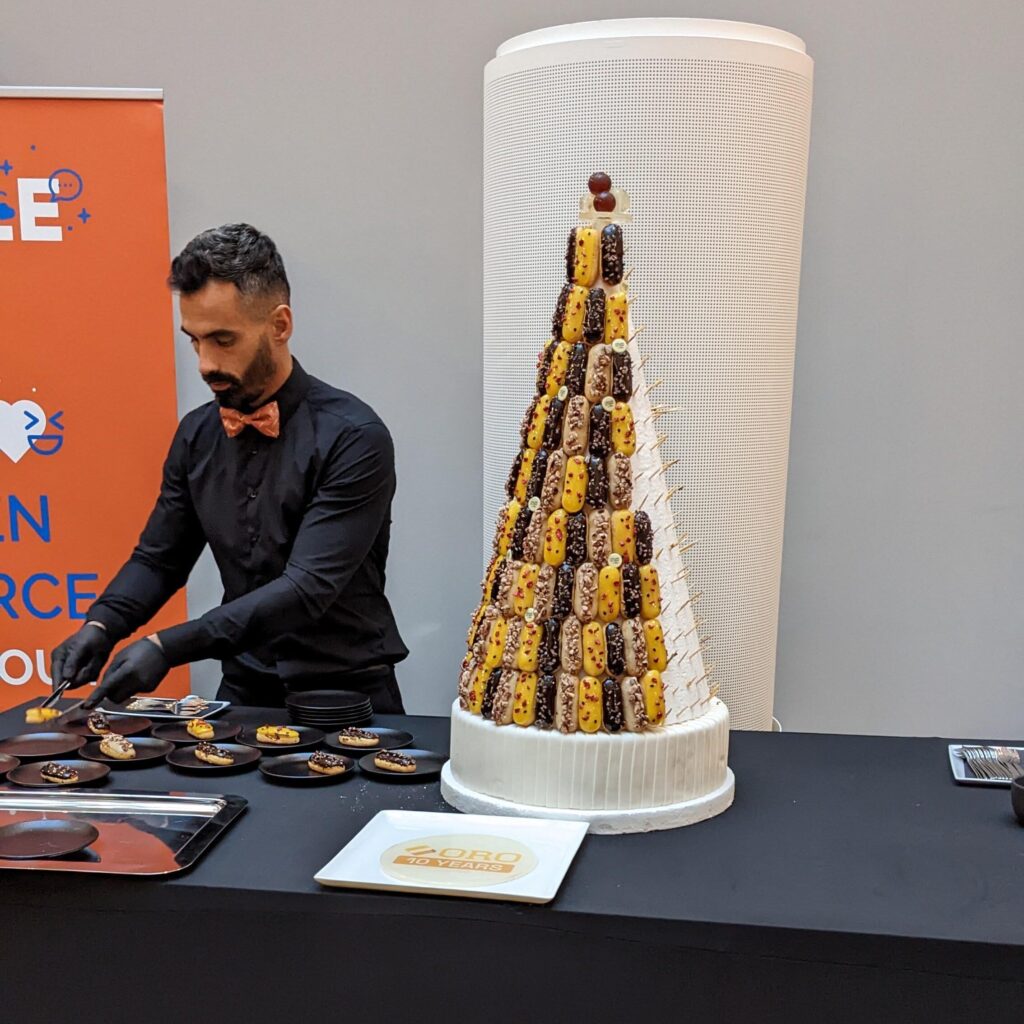
It was then time for the cocktail party, where it was great to speak to more Oro representatives, partners and customers; before setting off for the long journey back to the UK.
I eventually arrived back home late at night, feeling tired out, but very exhilarated about all of my amazing experiences from the last 36 hours!
Overall I found OroVibe to be a fantastic event, gained lots of useful insights, met some wonderful people, and feel extremely privileged to have had the opportunity to represent Generate UK there!